Search
To search for an exact match, type the word or phrase you want in quotation marks.
A*DESK has been offering since 2002 contents about criticism and contemporary art. A*DESK has become consolidated thanks to all those who have believed in the project, all those who have followed us, debating, participating and collaborating. Many people have collaborated with A*DESK, and continue to do so. Their efforts, knowledge and belief in the project are what make it grow internationally. At A*DESK we have also generated work for over one hundred professionals in culture, from small collaborations with reviews and classes, to more prolonged and intense collaborations.
At A*DESK we believe in the need for free and universal access to culture and knowledge. We want to carry on being independent, remaining open to more ideas and opinions. If you believe in A*DESK, we need your backing to be able to continue. You can now participate in the project by supporting it. You can choose how much you want to contribute to the project.
You can decide how much you want to bring to the project.
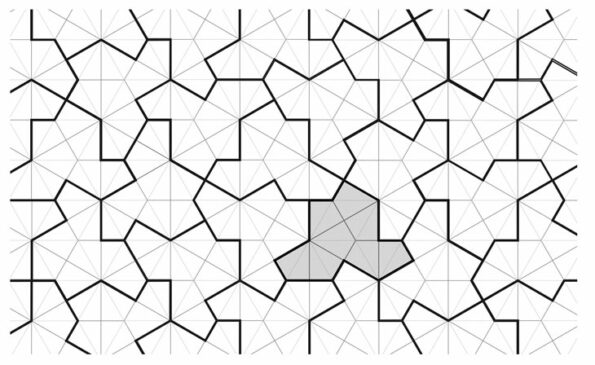
This text comes from a game that Aimar Perez Galí proposed to me a few weeks ago, that is, to consider spatial composition by introducing a constraint in the rules of its own language. Inspired by minimalist choreographer Lucinda Childs’ statement nothing personal, the game already contained a first exercise in abstraction, suggesting a spatial reading through the syntax of its geometric relationships. However, space… is quite personal. Detaching Euclidean space (x, y, z) from time and matter, and their interrelationships, is in itself an exercise in restriction and of speculative fiction.
It is difficult to put a limit on space. There are multiple interdependencies and it is as diverse as the very physics that constitutes it. As Karen Barad, physicist and feminist theorist, proposes, adding to the fact that space is inseparable from time, as the physicist Albert Einstein elucidated at the beginning of the 20th century in the Theory of Relativity, what we call Space is, in reality, spacetimemattering. Space is not detached from time nor from matter. Therefore, when we talk about Space we are also always talking about Time and Matter. When we talk about Time, Matter and Space are entangled in it. When we talk about Matter, this is Time and Space, too. Space is emergent, a system that cannot be reduced to its parts without dismembering the whole.
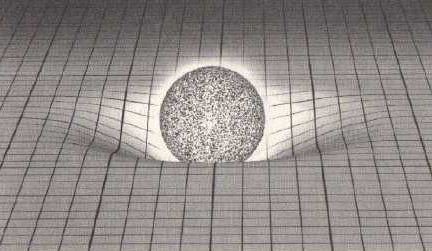
Spacetime curve
When composing space, not only do the Euclidean axes (x,y,z) and geometric bodies (point, line, plane, volume) intervene, but so too all the relationships, creatures, particles, events, materials, politics and matter that compose it, whether they are atmospheric, biological, geological, hydrological, quantum, chemical or geometrical (and many others). In fact, it is when one puts a limit on or tries to outline space that all the politics, frictions, interdependencies and ideologies that coexist and converge in it become visible. Geometry and mathematics are often considered as detached from political or ideological constructions, as even these carry in their structure specific inscriptions designed and elaborated in a specific space-time, with their respective decisions, obliterations and specific interests.
Regarding the composition of architectures, simply the force of gravity and the chemistry of materials are already determining restrictions for its design. As well as the traces left in the process and the future of any construction, be it spatial, temporal, social or ecological, and the interrelations between the inhabitants that this architecture will host[1]Multiple interrelationships between multiple inhabitants, human, more than human, electromagnetic (e.g. sun light) or even the water that comes out of the tap connected to an infrastructure that in … Continue reading.
Architecture is a creator of restrictions but also of possibilities. Drawing such apparently innocuous elements as a wall, door, or window as geometric figures on paper or on a screen are decisions that produce a lasting effect on materiality. From the graphite on the paper or the lines of computer bits, a future tangible composition is outlined that will produce a chain of events from the moment it is drawn until it materializes and is sustained over time. These lines, even if they are simply lines on a plane, as for example in Lars Von Trier’s film Dogville or the markings on a road, already affect movement, restrictions and the relationships that develop within them.
Drawing a line is already an act that per-forms and pre-forms future relationships and exclusions in the spacetimattering in which we are all entangled. The etymology of the Greek word graphia, translated as ‘writing,’ means inscribing a trace on earth/clay that forever changes the state of that matter, whether it is a line, language, or an abstract/administrative division between lands. Geography, calligraphy, cartography, orthography, scenography, choreography, phonography, musicography. Drawing in architecture is a spatiotemporal composition, like a musical score or writing, with its own codes and its own rules and restrictions embedded. By drawing a line, matter and time accumulate in it in a dense present[2]Haraway, Donna (2016). Staying with the Trouble. Making Kin in the Chthulucene. Durham: Duke University Press., a past modified from a present that projects a future and transforms it. An expanded temporality, which develops in time but is not progressive, like a relentless arrow of time headed towards the future, but rather accumulates past and future events from that present act of graphing.
During the architecture degree we receive several maxims about restriction: ‘Form follows function’ (Louis Sullivan), ‘Less is more’ (Mies van der Rohe), ‘Limitation makes the creative mind inventive’ (Walter Gropius), ‘Ornament and Crime’ (Adolf Loos), and Firmitas, utilitas, and venustas (Vitruvio). This is true for the design tools, as well, such as the Neufert Architect’s Data, which standardizes and indicates the optimal measurements in the use of spatial design, and in which bodies are magically exchanged by limiting the pre-defined uses of that space[3]In addition, Anthropometry, the science of the standardization of bodies used in the design of spaces, has its origin in the criminology sciences of the 19th century that differentiated the abject … Continue reading:

Neufert Architects’ Data. Bathroom measurements
Around the 1960s, coinciding with the North American Minimalist movement, the architect John Hejduk proposed the Nine Square Problem, right at the time George Perec joined the Oulipo group and Lucinda Childs began her interest in creating choreographies with geometric space patterns. For the Nine Square Problem, Hejduk designed an introductory pedagogical exercise to his students in schools of architecture in the United States in which he abstracted architecture from a diagram and its syntactic elements to focus on the spatial relationships between points and lines, pillars and walls, disassociating them from the relationships that emerge through the program’s needs and uses.
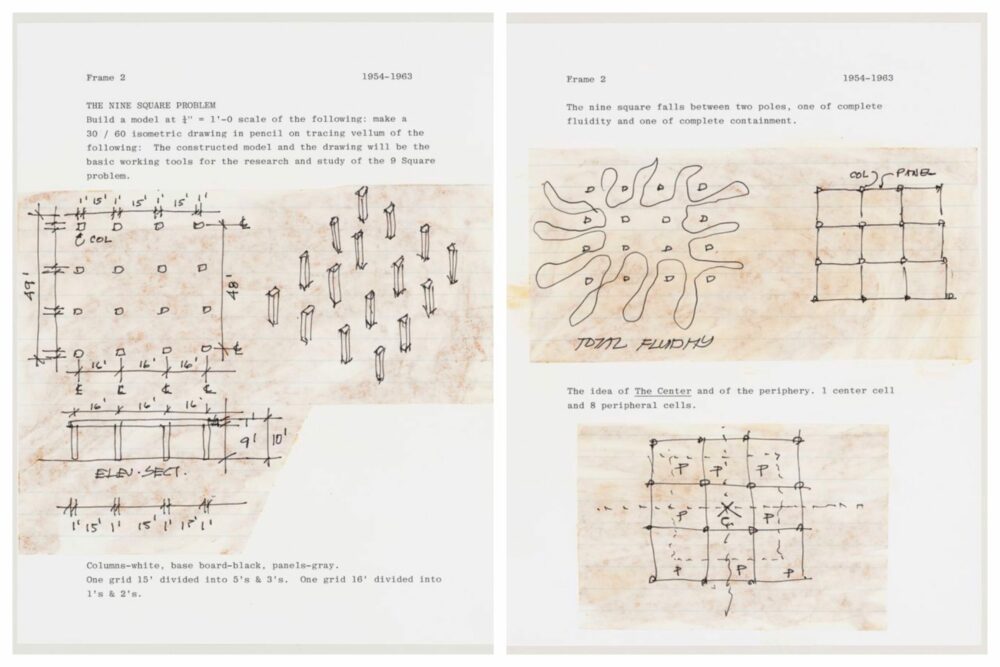
‘The Nine Square Problem’, John Hejduk (1954-1963-1985). Conceptual drawing with notes. John Hejduk fonds Collection Centre Canadien d’Architecture/ Canadian Centre for Architecture, Montréal
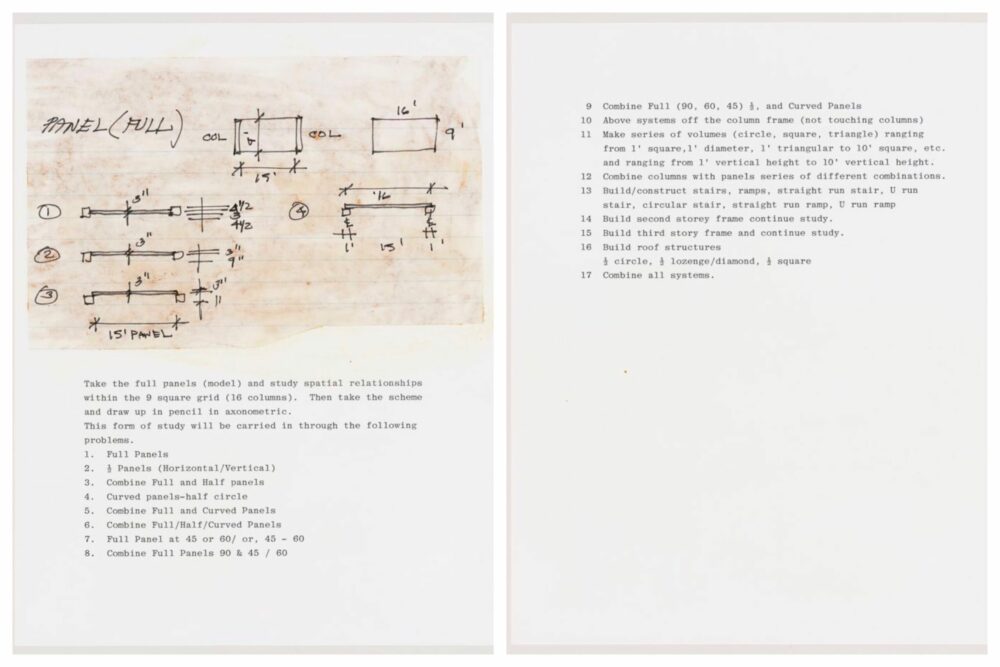
‘The Nine Square Problem’, John Hejduk (1954-1963-1985). Conceptual drawing with notes. John Hejduk fonds Collection Centre Canadien d’Architecture/ Canadian Centre for Architecture, Montréal
The aim of this exercise, conceptually connected to scientific thought and to the Western ontoepistemological tools of separation and differentiation and analysis by parts, was that students forget and get rid of the cultural and personal preconceptions with which they arrived to architecture school and to learn to design and compose space with, and from, geometric relationships on a grid in a uniform plane, considered the language of spatial composition.
However, Hejduk, after his geometry exercises, developed projects like Victims, which he described as “a construction of time.” In these projects he worked with another type of restriction, that is, precisely the inseparable link between geometry, the life it hosts and the place in which it unfolds, designing spaces for specific ways of inhabiting, such as ‘The House of the Suicide’ or ‘The House of the Mother of the Suicide.’
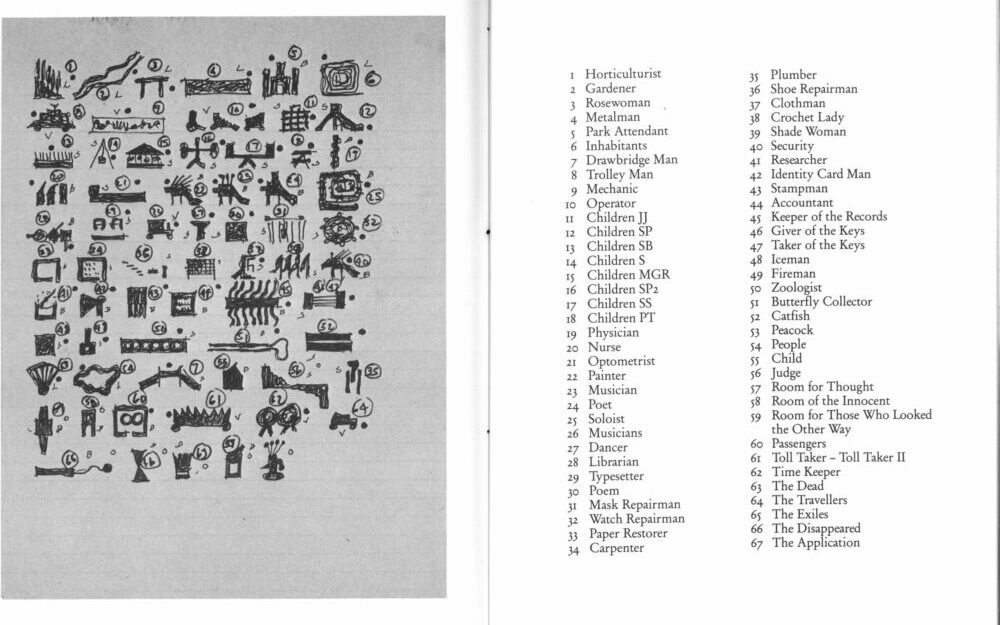
‘Victims’, John Hejduk. AA publication 1986
Spatial restrictions and considerations tend to be tied to their time. Material crises, social crises, ecological crises, even the delirious days of Starchitects when the possibilities introduced by digital design programs and unequally distributed wealth gave (and continue to give) rise to unnecessary extravagances. Time is a fundamental condition of architecture, its durability, also of a text or music, whose traces remain as technofossils for generations.
Given the conflicts of spatial composition in architecture, for the game of geometric restriction I would like to propose the aperiodic patterns[4]These structures are important for Material Sciences. For example, to understand the Quasicrystals, used in the development of sustainable energies and which, unlike their ‘noble’ … Continue reading used in mathematics, forms that can cover infinite surfaces without their patterns repeating.
The shape hobbyist (as he describes himself) David Smith[5]David Smith, seeing that he might have discovered the EinStein, contacted Craig S. Kaplan, an associate professor of computer science at the University of Waterloo in Canada, and later Dr. Chaim … Continue reading, recently found an aperiodic pattern, sought for years, that can be solved with a single piece, the EinStein (which despite sharing the name of the theoretical physicist Albert Einstein, mentioned at the beginning of this text, in this case means ‘a stone’).
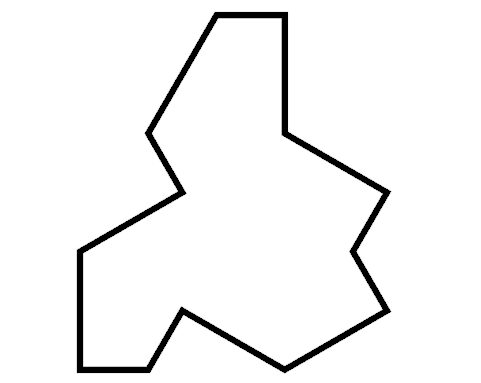
EinStein
This 13-sided polygonal outline generates an aperiodic pattern, which means it never repeats a form, no matter how far it is extended in space and time, creating aperiodicity simply by its geometry.
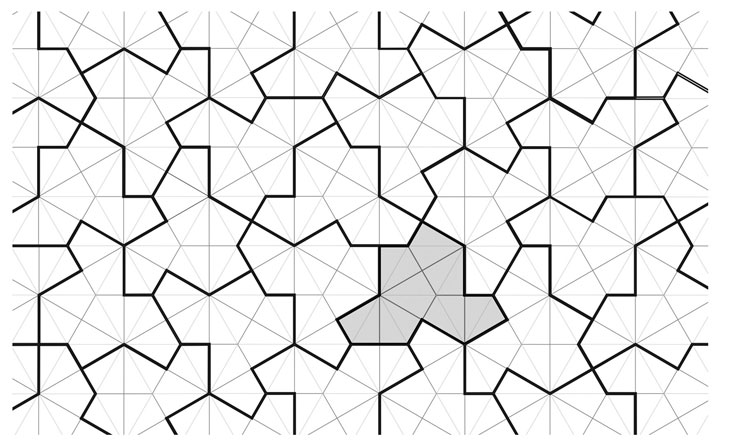
Aperiodic monotile. © Smith et al. / arXiv 2023
EinStein can be thought as a two-dimensional geometric spatial composition. A pattern that ceases to be a pattern when adding pieces, which by being able to assemble infinitely without repeating the pattern, it also incorporates variation over time, by generating movement through a non-static, non-symmetrical and aperiodic geometry. A pattern for a movement that never repeats.
It’s your turn now, Aimar. Perhaps you can try to introduce the EinStein in a choreographic composition to keep the game going.
All illustrations are from the Canadian Centre for Architecture (CCA), Montréal, available here.
| ↑1 | Multiple interrelationships between multiple inhabitants, human, more than human, electromagnetic (e.g. sun light) or even the water that comes out of the tap connected to an infrastructure that in turn is connected to other architectures and infrastructures, with their own regulations and protocols. |
|---|---|
| ↑2 | Haraway, Donna (2016). Staying with the Trouble. Making Kin in the Chthulucene. Durham: Duke University Press. |
| ↑3 | In addition, Anthropometry, the science of the standardization of bodies used in the design of spaces, has its origin in the criminology sciences of the 19th century that differentiated the abject from the “normal” body. See Blanca Pujals, 2016, Bodily Cartographies. Pathologizing the Body and the City. The Funambulist Magazine #7 on Health Struggles. Design as Problem-Making. Barcelona: BAU Ediciones, pp. 15-26. |
| ↑4 | These structures are important for Material Sciences. For example, to understand the Quasicrystals, used in the development of sustainable energies and which, unlike their ‘noble’ relatives, the crystals, where atoms are organized symmetrically in shapes that repeat themselves indefinitely, in the case of the Quasicrystals their structure is ordered but aperiodic. |
| ↑5 | David Smith, seeing that he might have discovered the EinStein, contacted Craig S. Kaplan, an associate professor of computer science at the University of Waterloo in Canada, and later Dr. Chaim Goodman-Strauss, a mathematician at the University of Arkansas, and Dr. Joseph Myers, a software developer in Cambridge, England, and on March 20 they jointly published the article ‘An Aperiodic Monotile.’ |

Blanca Pujals is an architect, spatial researcher and critical writer. Her cross-disciplinary practice uses spatial research and critical analysis to engage with questions around geographies of power on bodies and territories, and geopolitical configurations of contemporary techno-scientific infrastructures. Her work encompasses film, architecture, lecturing, curatorial projects, teaching and critical writing.
Graduated in Architecture at the Barcelona School of Architecture, she completed her studies with a MA in Critical Theory and Museum Studies at the Independent Studies Program of MACBA Museum, tutored by the philosopher Paul B.Preciado, and a postgraduate degree from the Centre for Research Architecture (Visual Cultures Department) at Goldsmiths University of London, directed by Susan Schuppli and Eyal Weizman. She is currently developing her practice-led PhD in Art&Science, about the geopolitics and spatial articulations of Particle Physics’ Sensing Infrastructures, looking at fundamental physics laboratories such as CERN (The European Organization for Nuclear Research) and how they amplify material and political interactions.
"A desk is a dangerous place from which to watch the world" (John Le Carré)